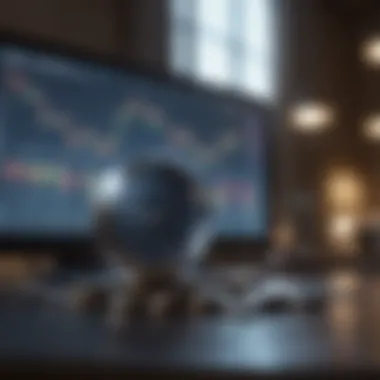Navigating Today's Stock Market Futures Landscape


Intro
The stock market today operates as a complex system, influenced by various factors including economic indicators and investor behaviors. Investors often turn to futures trading as a strategy to capitalize on these fluctuations. This section will serve as a foundational understanding of the current state of stock market futures.
Futures contracts are agreements to buy or sell an asset at a predetermined price at a specified time in the future. They offer leverage and can serve both as a hedge against losses and a means for speculative investment. Understanding how futures work is crucial for any investor looking to partake in this arena.
Market Overview
Current Market Trends
Today, the stock market displays a blend of optimism and caution. Many investors are navigating through post-pandemic recovery while being aware of potential risks, such as inflation or geopolitical tensions. Futures are significantly influenced by these trends, as they reflect the anticipated performance of underlying assets in the short to medium term.
Key Market Indices Performance
Indices such as the S&P 500 and the Nasdaq have shown diverse performance. The S&P 500, often viewed as a barometer for the U.S. economy, has been relatively stable but with fluctuations influenced by specific sectors. On the other hand, the technology sector, represented prominently by the Nasdaq, has shown increased volatility.
Economic Factors Influencing the Market
Several economic indicators impact stock market futures. These include:
- Interest Rates: Changes in Federal Reserve policies can shift market sentiments.
- Employment Data: Job reports often reveal the strength of the economy, influencing investor confidence.
- Consumer Price Index: Inflation can directly affect purchasing power and corporate earnings, leading to future market adjustments.
Sector Spotlight: Leading Sectors Affected by Trend
Certain sectors are more susceptible to market changes. Utilities and consumer staples tend to be less volatile, while technology and energy sectors can experience rapid shifts. Investors should pay close attention to these sectors when considering futures trading, as they can provide insights into overall market sentiment.
Stocks in Focus
High-Performance Stocks: Analysis and Recommendations
Seeking high-performance stocks requires identifying companies with robust fundamentals and consistent growth. Stocks like Apple and Microsoft continue to show strong performance, driven by innovation and robust demand. Investing in these types may yield better returns in futures trading due to their reliability.
Undervalued Stocks: Opportunities for Investment
Identifying undervalued stocks presents a unique opportunity. Companies like Coca-Cola have solid fundamentals yet may not reflect their true value in the current market. Buying these stocks can create a strategic advantage in the long run, particularly with futures contracts.
Emergent Stocks: Innovations and Market Entry
Emergent stocks often signal new trends and innovations. Look for companies like Rivian, which are disrupting traditional markets. Their stock prices may be volatile, but understanding the underlying technology and market dynamics can inform better futures trading decisions.
Investment Strategies
Short-Term vs Long-Term Investment Approaches
Futures trading can align with both short-term and long-term investment strategies. Short-term traders often focus on quick gains, while long-term investors take a more measured approach, focusing on the eventual performance of assets. Each strategy has its own risks and rewards.
Risk Management Techniques
Effective risk management is paramount. Diversification in futures contracts can help mitigate risks. Implementing stop-loss orders can also protect against significant losses, allowing investors to maintain control.
Diversification: Building a Balanced Portfolio
Constructing a balanced portfolio is essential for long-term success. Including a mix of asset classes can safeguard against market volatility. Investors should allocate a portion to futures that reflects their risk tolerance and investment goals.
Value Investing vs Growth Investing
Deciding between value and growth investing can impact futures trading decisions. Value investing focuses on undervalued stocks with strong fundamentals, while growth investing is centered on stocks expected to grow at an above-average rate. Each method has its unique advantages in the context of futures.
Tools & Resources for Investors
Interactive Stock Charts and Tools
Utilizing tools such as ThinkOrSwim or Yahoo Finance can enhance market analysis. These platforms provide interactive charts, allowing investors to visualize trends and make informed decisions.
Calculators: Investment, Retirement, and Profit
Various calculators are available to assist with investment decisions. Tools for calculating compound interest and return on investment can provide clarity on potential futures profits.
Educational Resources: Articles, and Tutorials


Investors should continually educate themselves. Websites like Investopedia and Wall Street Journal offer valuable insights and learning materials on futures trading and market dynamics.
Market Analysis Reports: What to Look For
Regular market analysis reports can provide clarity on futures pricing trends. Look for reports that analyze market sentiment and economic indicators to inform your futures strategy effectively.
Personalized Investment Planning
Assessing Personal Financial Goals
Before diving into futures trading, individuals should assess their financial goals. Understanding whether the aim is for retirement savings or short-term profit can shape investment strategies.
Creating a Tailored Investment Strategy
Each investor should create a strategy tailored to their particular risk tolerance and investment horizon. Outcomes can vary significantly, thus having a personalized approach is beneficial.
Regular Portfolio Reviews
Keeping track of your investments is crucial for success. Regular portfolio reviews help investors adjust strategies in response to market changes and personal financial developments.
Consulting Services: When to Seek Professional Help
Sometimes investors may benefit from professional advice. Consulting financial advisors can help in creating more effective futures strategies, particularly for those less experienced in the market.
Understanding Futures in the Stock Market
The stock market plays a pivotal role in the financial ecosystem, and understanding its various components is crucial for potential investors. Futures represent an essential aspect of this environment. They provide a mechanism for managing risk and speculating on future price movements. Investors need to grasp the implications and functionality of futures to make informed decisions.
Definition of Futures
Futures are standardized contracts that obligate the buyer to purchase, and the seller to sell, an asset at a predetermined price at a specified future date. This asset can be commodities like oil or gold, or financial instruments such as stock indices or treasury bonds. The essence of a futures contract lies in its binding nature, which allows parties to hedge against price fluctuations or engage in speculative activities. By locking in prices, futures enable investors to navigate volatility effectively.
Role of Futures in Investment Strategies
Futures can be central to various investment strategies. They give investors an opportunity to protect their portfolios, especially during turbulent market conditions. For instance, a farmer could use futures to safeguard against falling crop prices by locking in a price ahead of harvest. Similarly, companies can hedge against potential increases in costs, ensuring more predictable profit margins. Futures can also serve speculators seeking to profit from market movements. Investors can gain exposure to assets without needing to own them outright, which results in lower initial capital requirements.
- Hedging: Reduces risk by locking in prices.
- Speculation: Allows investors to bet on price movements, potentially yielding high returns.
- Leverage: Futures contracts often require only a fraction of the total value as initial margin, maximizing potential returns but also risks.
Differences Between Futures and Options
Understanding the distinction between futures and options is crucial for investors. Futures contracts obligate both parties to fulfill the contract at expiration, while options give the holder the right but not the obligation to execute the contract. This means that futures carry a commitment that can lead to significant losses or gains upon expiration. In contrast, options limit potential losses to the premium paid.
Key Differences:
- Obligation: Futures require fulfillment; options provide the right to execute.
- Risk and Reward: Futures often lead to greater exposure, whereas options can limit maximum losses.
- Cost Structure: Futures typically have no upfront cost beyond margin requirements, whereas options require premium payment.
Futures and options offer unique tools for investors, each with distinct characteristics that can complement varied strategies in market environments.
Grasping the nuances of futures in the stock market is fundamental for both novice and seasoned investors. The mechanics behind these contracts, their strategic applications, and their inherent risks are indispensable in crafting a robust investment approach.
Current Market Conditions
Current market conditions are critical to understanding the dynamics of futures trading. When investors assess futures, they must consider the broader market environment. Various factors including economic indicators, sentiment, and global events confluence to create a complex landscape. Navigating this landscape effectively enhances investment strategies and risk management practices for both novice and experienced traders.
Market Sentiment Analysis
Market sentiment reflects the overall attitude of investors toward a particular security or financial market. It is a crucial element that can significantly influence futures prices. When sentiment is bullish, investors are likely to buy futures contracts, anticipating that prices will rise. Conversely, bearish sentiment can lead to selling pressure, resulting in price declines. Analysts often use tools like surveys and market trends to gauge sentiment.
To understand sentiment better, consider the following:
- Investor Reports: Regular analyses often reveal shifts in investor confidence.
- Social Media Trends: Platforms like Reddit and Facebook can indicate prevailing moods.
- Market Volatility: High volatility typically corresponds with nervous sentiment.
“Understanding market sentiment is essential. It can provide a clear direction on where futures prices may head next.”
Impact of Economic Indicators
Economic indicators are statistical metrics that signal the economic health of a country. Important indicators include GDP growth, employment rates, and inflation figures. These metrics can greatly impact futures trading decisions. For example, if employment rates rise, consumer spending may increase, leading to higher demand for commodities. This, in turn, can support futures prices for those commodities.
Key indicators that traders monitor are:
- Consumer Price Index (CPI): A measure of inflation, directly impacting purchasing power and market prices.
- Gross Domestic Product (GDP): Indicates overall economic performance.
- Employment Figures: Reflects the health of the labor market and consumer spending capacity.


Traders must stay alert to these indicators as they shape the broader economic context in which futures operate.
Global Events Influencing Futures
Global events can have immediate and profound effects on futures markets. Political instability, natural disasters, and economic policy changes can create uncertainty and affect supply chains. For instance, tensions in a major oil-producing region can spike oil futures prices due to fears of supply disruptions. Similarly, trade agreements or tariffs can change the landscape for agricultural futures, affecting prices dramatically.
To illustrate, consider these global factors:
- Geopolitical Issues: Conflicts or tensions can result in supply limitations, pushing prices higher.
- Natural Disasters: Events like hurricanes can disrupt production, particularly in agriculture.
- Economic Sanctions: Sanctions on countries can lead to volatility in commodity futures related to those economies.
Understanding these global influences is crucial for traders as they navigate the complexities of futures trading in today's interconnected world.
Futures Trading Mechanics
Futures trading mechanics are fundamental for understanding the current landscape of the stock market. This section offers insights into how futures contracts operate, the role of margin requirements, and the settlement processes. Investors must grasp these mechanics to make informed decisions and manage risks effectively.
How Futures Contracts Work
Futures contracts are legally binding agreements to buy or sell an asset at a predetermined price at a specific date in the future. This contract functions as a tool for hedging against price fluctuations, providing a strategic approach for investors. The underlying assets can range from commodities to financial instruments.
In a futures contract, both parties are required to fulfill the terms regardless of the market's direction at expiration. This aspect creates a critical element of obligation and can lead to significant gains or losses. Understanding how prices are determined and how these contracts function is essential for both novice and experienced investors.
Moreover, the trading of futures often involves exchanges, where prices are continuously adjusted based on market conditions. These adjustments reflect supply and demand and can result in rapid price changes, making it essential to monitor the markets closely.
Margin Requirements and Leverage
Margin requirements are a key component of futures trading. When an investor enters into a futures contract, they are normally required to put down a margin, which is a portion of the total contract value. This margin acts as a security deposit and can vary based on the asset and market conditions.
Leverage is a significant benefit of futures trading. It allows investors to control a larger position than what they would otherwise be able to with their own capital. However, while leverage amplifies potential returns, it also increases the risk. Investors must be cautious; a small price change can lead to substantial losses.
The use of leverage in futures trading can lead to profitable outcomes but carries inherent risks that investors must fully understand.
Thus, investors need to maintain sufficient margin to avoid margin calls, where they are required to deposit additional funds to maintain their positions. Staying informed about margin requirements and leveraging effectively is vital in managing trading risks.
Settlement and Delivery Processes
The settlement and delivery processes are crucial aspects in futures trading. There are typically two methods of settlement: cash settlement and physical delivery. Cash settlement involves compensating profit or loss without exchanging the underlying asset. This method is common for financial futures like index options.
Physical delivery, however, requires the actual transfer of the underlying asset at contract expiration. This is more common in commodities like oil or wheat. Understanding these processes helps investors strategize their exit plans, whether they intend to close out a position prior to expiration or fulfill the delivery.
It is essential to monitor the expiration dates and the obligations surrounding settlement. Failure to comply can result in unintended deliveries or cash settlements which may not align with an investor’s strategy or objectives.
In summary, comprehending the mechanics behind futures trading—how contracts work, knowing margin requirements and leverage, and understanding settlement processes—is essential for any investor engaging in this financial landscape. This knowledge equips investors with the tools needed to navigate futures trading successfully.
Factors Affecting Futures Prices
Understanding the factors that influence futures prices is essential for investors navigating today's volatile stock market. Futures prices are not determined in isolation; they reflect a complex interplay of various elements that can shift rapidly based on economic, political, and market-specific conditions.
Supply and Demand Dynamics
At the core of futures pricing lies the basic economic principle of supply and demand. When demand for a commodity or financial instrument increases, prices tend to rise. Conversely, when supply outstrips demand, prices tend to fall.
In the context of stock market futures, this can mean several things. For example, if there is increased purchasing activity in a specific sector, futures contracts tied to that sector tend to increase in value. Market participants must constantly monitor supply and demand indicators to anticipate price movements effectively. Economic reports, industry growth forecasts, and consumer behavior are all significant inputs in this analysis.
Investors often analyze factors like inventory levels, seasonal variances, and even weather conditions, which can heavily influence commodity prices.
Interest Rates and Inflation
Interest rates and inflation are also critical determinants of futures prices. Central banks use interest rates as a tool to control inflation, impacting the cost of borrowing. Higher interest rates typically lead to an appreciation in the currency's value, affecting export competitiveness and thus impacting the prices of commodity futures.
Inflation, as measured by indexes such as the Consumer Price Index (CPI), influences investor sentiment. Rising inflation can erode purchasing power and prompt investors to seek safe-haven assets, which can shift futures away from equities toward commodities like gold or oil.
In summary, both interest rates and inflation can create fluctuations in futures markets that require astute observation and timely decisions.
Geopolitical Factors
Geopolitical factors are another layer in determining futures prices. Political stability, international relations, and events like trade wars have direct repercussions on market mechanisms. For instance, tensions in oil-producing regions can cause oil futures prices to spike due to perceived supply risks. Similarly, regulatory changes in major economies can impact futures linked to currencies and commodities significantly.
Market participants should keep a pulse on global affairs. A report from an influential nation can result in sudden shifts in investor confidence, which in turn affects trading volumes and prices across various futures.
Strategic Approaches to Futures Trading


Understanding how to navigate the world of futures trading is crucial for any investor looking to leverage this particular market. Futures can offer unique opportunities but also present substantial risks. A strategic approach can mean the difference between profit and loss. This section explores essential methodologies that investors can employ to optimize their trading outcomes.
Risk Management Techniques
Risk management is the bedrock of any trading strategy, especially in the volatile world of futures. It involves identifying potential risks and taking steps to minimize those risks. Here, investors focus on three main aspects:
- Position Sizing: This method helps manage how much of the portfolio is exposed to a particular trade. Investors may use a percentage of their total capital to determine their position size, ensuring that no single trade negatively impacts their overall financial stability.
- Stop-Loss Orders: Implementing stop-loss orders allows investors to set predetermined exit points for their trades. By doing so, they can limit losses and protect their capital from unexpected market movements.
- Diversification: Distributing investments across various asset classes can lessen risk exposure. A well-diversified portfolio may yield smoother returns compared to concentrating investments in a single market phase.
Effective risk management is not just about avoiding losses; it’s about building confidence in your trading decisions.
Hedging Against Market Fluctuations
Hedging is a critical strategy in futures trading to safeguard against potential price movements that could harm an investment. It acts as an insurance policy in volatile markets. The primary techniques include:
- Long and Short Positions: Investors may take long positions in futures contracts if they anticipate a rise in prices. Conversely, short positions are placed when they expect prices to decrease. This dual approach can protect profits against adverse market trends.
- Cross-Hedging: This involves taking a position in a futures market to guard against risk in a different but related market. For instance, an investor might hedge their stock holdings with oil futures if they believe that fluctuating oil prices will impact their stock performance.
- Using Inverse ETFs: Inverse exchange-traded funds are designed to move in the opposite direction of a specific index. Investors may utilize these in tandem with futures contracts to enhance their defensive strategies.
Speculating on Futures Trends
Speculation involves making educated guesses based on market analysis. Traders can profit from predicting future price movements, but it’s essential to approach these strategies with a thorough understanding:
- Technical Analysis: Traders often study price charts and utilize various technical indicators to forecast future price movements. Familiar tools include moving averages and relative strength indexes, which help in identifying potential market entry and exit points.
- Fundamental Analysis: This method centers on intrinsic factors that affect market prices. Investors may analyze economic data, company earnings, or global political events to determine potential trends in futures prices.
- Sentiment Analysis: Monitoring market sentiment can provide insights into traders’ emotions. A highly bullish sentiment may signal a potential market correction, while excessively bearish sentiment might suggest opportunities for buyers.
Understanding these strategic approaches is crucial for maximizing the potential rewards in futures trading. They allow investors to navigate uncertainties while pursuing their financial goals.
Technological Advancements in Futures Trading
The integration of technology into futures trading has transformed the landscape of this investment avenue. This is not just about speed; it’s about precision, opportunity, and expanding trading possibilities. Rookie investors and experienced traders now operate in a world powered by advanced algorithms, data analysis, and blockchain implementations. Understanding these advancements is crucial for anyone looking to thrive in the futures market today.
Algorithmic Trading in Futures
Algorithmic trading represents a shift in how traders execute trades. By using mathematical models and automated systems, algorithmic trading allows for the swift execution of orders based on predetermined criteria. This enhances efficiency in the market.
Some advantages of algorithmic trading include:
- Speed: Trades can be executed within milliseconds, capturing opportunities before they vanish.
- Reduced Costs: It lowers the costs associated with trading as human errors and delays are minimized.
- Backtesting: Traders can test their strategies against historical data to see how they would have performed.
However, algorithmic trading is not without risks. Market conditions can change rapidly, and algorithms may not adapt quickly enough, leading to significant losses. Investors must understand the systems they use to avoid pitfalls.
Impact of Data Analytics
Data analytics is another key driver of change in futures trading. The ability to analyze large volumes of data has become essential. Investors can now utilize predictive analytics to forecast market trends more accurately. With the historical and real-time data available, they can spot patterns that were previously invisible.
The influence of data analytics includes:
- Informed Decision-Making: Traders rely on analytics to make decisions based on concrete data rather than gut feeling.
- Performance Measurement: Investors can assess the effectiveness of their strategies using analysis tools.
- Risk Assessment: By analyzing trends and anomalies, traders identify risks before they escalate.
Nevertheless, these advantages require a significant investment in analytics tools. The challenge remains for smaller investors to access the same level of data and insights that larger institutions possess.
Emergence of Blockchain and Cryptocurrencies
Blockchain technology is gradually finding its way into futures trading. The decentralized and transparent nature of blockchain provides numerous benefits. The system reduces traditional role players, like intermediaries, resulting in lower transaction costs and enhanced security for futures contracts.
Benefits of blockchain in futures trading include:
- Transparency: All transactions can be verified by network participants, which builds trust in the market.
- Reduction in Settlement Times: Traditional clearing and settlement processes can take time; blockchain can expedite this.
- Increased Security: The immutability of blockchain means that data cannot be altered easily, protecting investors from fraud.
However, integrating blockchain into existing systems presents challenges. Regulations surrounding cryptocurrencies continue to evolve, causing uncertainty in trading practices.
"The future of futures trading is likely to be dictated by technological advancements, which will enhance efficiency, security, and accessibility for investors of all backgrounds."
Epilogue and Future Outlook
Understanding the conclusion and future outlook regarding futures trading is essential for any investor. It synthesizes the key points discussed earlier while offering insights into the potential direction of the market. Futures trading is not just a tool for hedging; it also allows speculation, which makes it vital to grasp its implications for the coming months or years.
Summary of Key Insights
- Market Sentiment: Current market conditions show that investor sentiment can significantly affect futures prices. A bullish sentiment often drives higher futures prices, whereas a bearish outlook leads to declines.
- Economic Indicators: Economic data, such as unemployment rates and GDP growth, play crucial roles in shaping expectations around futures. Investors watch this data closely.
- Technological Changes: Advancements in technology, especially in algorithmic trading and data analytics, are transforming how futures trading occurs. This creates both opportunities and challenges for investors.
Resources for Further Learning
Understanding futures in the stock market is crucial for navigating this complex financial landscape. This section highlights various resources for further learning, which will enhance knowledge and improve trading acumen for both novice and experienced investors. By expanding your knowledge base, you can gain valuable insights and dive deeper into futures trading, which can ultimately lead to more informed decision-making.
Recommended Books on Futures Trading
Books can provide an essential understanding of futures trading. They present theories, practical strategies, and real-world examples, making complex concepts accessible. Here are some recommended titles:
- **







